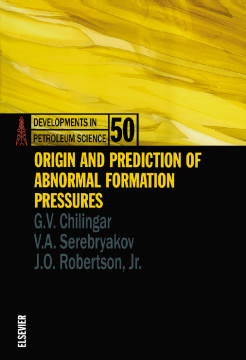
BOOK
Origin and Prediction of Abnormal Formation Pressures
V.A. Serebryakov | J.O. Robertson, Jr. | G.V. Chilingarian
(2002)
Additional Information
Book Details
Abstract
Knowledge of the presence of abnormally-high pressure zones (AHFP) prior to drilling into them can prevent considerable economic losses and, possibly, save human lives.
The various origins (undercompaction, tectonics, etc.) of AHFPs are discussed, followed by the description of predictive techniques in clastic, carbonate and salt-bearing formations. In addition to the well-logging predictive techniques, the authors discuss smectite-illite transformation and the chemistry of interstitial solutions. Other topics covered include (a) abnormally low formation pressures and subsidence, and (b) mathematical modelling. Loss of potential production may result if AHFPs are not properly identified and evaluated. Many hydrocarbon-bearing formations with AHFPs are erroneously "condemned".
This book is of interest to engineers and geologists involved in the (a) evaluation, (b) drilling in, (c) completing, and (d) producing from hydrocarbon reservoirs with AHFPs.
Y.A. Kettanah and M.R. Islam
...this book is the most comprehensive and complete publication written so far on the subject of abnormal formation pressures. We recommend it to the scientists, engineers, and technicians working in petroleum industry. It is specially recommended to the students of geology, geophysics, petroleum engineering, and other branches of engineering as it makes an excellent text book that addresses research topics of utmost importance.
Energy Sources
J.F. Burst
...Bringing together a generational compendium of authors, Chilingar shows, once again, a masterful understanding of the problem. ...This is a publication of consequence. ...Also noteworthy is that many invaluable contributions of Russian and former Soviet Union scientists that were originally published in Russian are included in this volume, which will become a classic reference for all petroleum geologists and engineers.
AAPG Bulletin
